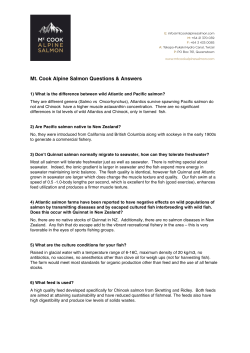
Learn More - Port of Lewiston
200 of those 400 would reach Lower Granite 143 would make it past all 8 dams on the Reservoir. 50% would fall Columbia-Snake River System. victim to nonnative and native fish predators and 100 would make it to the Pacific Ocean, from Upon reaching the first dam—Lower birds. Granite Dam—50% should be transported Bonneville Dam because: and 50% allowed to migrate in-river. Survival through the 16% would be eaten by Caspian terns reservoir is about 96%, so 98% would survive transport, so 94 (leaving 120) 192 would reach Lower transported fish would reach below 6% by cormorants (leaving 113) Granite Dam. Bonneville Dam. 1% by gulls (leaving 112) 10% by predacious fish (leaving 101) 1% by seals and sea lions (leaving 100) 51% would survive in-river migration, so 49 would join the above 94 for the total of 143. 400 of those 5,000 eggs would produce smolts in 1-3 years. 92% would have died before migration to the sea began. Some eggs wouldn’t hatch, some eggs would fall prey to microorganisms, like fungus or parasites, and some developing eggs and fish would be eaten by other fish and birds. 5,000 eggs (the average amount) are laid by 2 Spring Chinook salmon in Snake River spawning grounds. Assuming a return of 2 adults, 99.96% of the progeny would die somewhere between the laying of the eggs and the return of two adults to the spawning grounds. This presents a general idea of where salmon mortality can occur based on a multitude of research projects funded primarily by the Corps of Engineers and the Bonneville Power Administration over the past four decades. It is adapted from “Where Salmon Die,” a document produced by John McKern of Fish Passage Solutions, LLC. Of the 4,998 fish that die in this example, the death of 57 juvenile and one adult salmon could be attributed to the Federal dams. 12 adults would start the journey from the ocean back to spawning grounds. This is because ocean conditions, availability of food and an abundance of predators would reduce the 100 that made it to the ocean by 88% over the 2-3 years spent in the sea. 5 salmon would reach Bonneville Dam to migrate on because: up to 11% could be caught before leaving the ocean, leaving 11 fish to enter the estuary. 4 adults would make it past the Up to 40% would be eaten by 6,000 seals and 1,600 sea lions dams. between the ocean and Bonneville Dam, leaving 7 to migrate With a 1% loss at each of the upriver. eight dams, 92% would make it If commercial and sport fishing and Indian fisheries above Bonneville Dam (governed by US v Oregon) take 30%, that would leave the 5 salmon to migrate on. past Lower Granite Dam, reducing the return by one adult to 4. 1626 6th Avenue N Lewiston, Idaho 83501 | 208.743.5531 | portoflewiston.com 2 would ultimately return to spawn. Because, of the four making it past the dams, 50% would die from the rigors of migration, development of eggs and sperm, warm waters and disease in spawning areas, or from unhealed injuries from seals, sea lions or gill nets below Bonneville. March 31, 2015 JL McKern, Fish Passage Solutions, LLC WHERE IDAHO SALMON DIE By John McKern Fish Passage Solutions, LLC* 1. Question: If two adult spring Chinook salmon, a male and a female, reach Snake River spawning grounds in Idaho, what survival rate would ensure that two adult salmon would return to spawn in the next generation, thereby sustaining the population? 2. Answer: ** On average, Snake River spring Chinook lay about 5,000 eggs. To return two adults would require a 0.04% (2/5,000) egg-to-adult return. Assuming this return, 99.96% of the progeny would die somewhere between the laying of the eggs and the return of two adults to the spawning ground. This is a generalized example of where that mortality would occur given 2015 conditions. 3. Egg-to-smolt survival: Studies of wild spring Chinook spawning success in the Lemhi River indicate that under normal circumstances, well over 90% of the eggs laid by the female would be fertilized by the male (or males). In the gravel, some eggs would perish because they were not perfectly formed. Others would fall prey to microorganisms like fungus or parasites. Developing eggs and young fish might be eaten by fish like sculpins, cutthroat, or bull trout, or by birds like dippers or mergansers. Of the 5,000 eggs laid, up to 400 would produce smolts in one to three years. That means 92% (4,600/5,000) would have died before migration to the sea began. 4. Mortality in the migration corridor: Recent PIT tag studies indicate that about 50% of the juvenile salmon survive from hatcheries to Lower Granite Reservoir. Survival of hatchery fish ranged from 20 to 70% directly related to the distance traveled in the open river to Lower Granite. Sawtooth Hatchery on the upper Salmon River had the lowest survival while Dworshak on the lower Clearwater had the highest. With wild fish PIT-tagged in upper tributaries the summer before migrating, NOAA Fisheries found that, of the fish tagged the summer before migrating, most of the tagged fish died over winter due to rearing area conditions. Wild fish survive migration as well or better than hatchery fish, so in this example about 50% mortality is estimated to occur from the Lemhi down the Salmon and Snake rivers. Nonnative predator fish including bass, catfish, and walleye, the native northern pike minnow, and increasing populations of fish-eating birds (mergansers, terns, cormorants, western grebes, and gulls) would cause most of the mortalities. Of the 400 smolts that started the migration in Idaho, an estimated 200 would reach Lower Granite Reservoir. Survival through the reservoir, according to PIT tag studies, would be about 96%, so 192 would reach Lower Granite Dam. According to the NOAA Fisheries Service Biological Opinion, 50% of the fish should be transported and 50% should be allowed to migrate in-river. Of the 96 fish transported, 98% would survive collection at the dam and transportation by the barge or truck, so 94 fish would be released below Bonneville Dam alive. Of the in-river migrants, assuming they were not collected and transported from Little Goose or Lower Monumental Dam downstream, PIT tag 1 March 31, 2015 JL McKern, Fish Passage Solutions, LLC studies indicate that an average of 92% would survive each dam and reservoir project. Again, native and nonnative fish, and birds would cause most mortalities. Combining survival from Lower Granite through the next seven projects, 51% would survive in-river migration. Of the 96 fish bypassed or spilled down the river, 49 would join the 94 transported for a total of 143 migrating below Bonneville. While migrating on to the sea, about 16% would be eaten by Caspian terns leaving 120. Another 6% would be eaten by cormorants leaving 113, and 1% by gulls leaving 112. Another 10% would be eaten by predacious fish leaving 101. Seals and sea lions would take another 1% leaving 100 to enter the ocean. 5. Ocean survival: Ocean conditions, availability of food and an abundance of predators, would reduce this number by 88% over the next 2 to 3 years leaving 12 adults to start the journey from the ocean back to the spawning grounds. Sport and commercial fishing are closely regulated in U.S. waters according to a composite of legal actions known as U.S. v Oregon administered by a Federal Court. British Columbia fisheries are also regulated according to international agreements. Depending on predicted abundance of the return to the Columbia, up to 11 percent could be caught in the ocean, leaving 11 fish to enter the estuary. 6. Upstream migration: Up to 40% would be eaten by over 6,000 seals and 1,600 sea lions between the ocean and Bonneville Dam, leaving 7 to migrate upriver. If commercial and sport fishing in the lower river and Indian fisheries above Bonneville Dam took 30% (governed by US v Oregon), 5 salmon would migrate on toward the spawning grounds. Radio-tracking studies by University of Idaho researchers indicate over 99% survival per dam in the Snake River, and similar survival occurs at Columbia dams which have equally effective fish ladders. Assuming then a 1% loss at each of the eight dams, 92% would make it past Lower Granite Dam, reducing the return by one adult to 4. 7. Spring Chinook that enter the river in April and May must survive without eating until they spawn in September. Typically, about 50% would die from the rigors of the migration and development of sexual products (eggs and sperm), from warm waters and disease in spawning areas, or from unhealed injuries from seals, sea lions, or gill nets below Bonneville. That would leave approximately 2 to spawn. 8. Man-caused mortality: Of the 4,998 fish that died in the example above, the death of 57 juvenile and one adult salmon could be attributed to the Federal dams. However, numbers of fish-eating birds have increased dramatically in the past few decades because man has dramatically reduced the use of DDT and other chlorinated hydrocarbon pesticides. These contaminants caused egg-shell thinning in birds at the top of the food web, severely depressing their reproduction. Now, tens of thousands of terns, cormorants, and pelicans nest from the estuary into eastern Washington and some prey on fish as far upstream as the Idaho border. Mergansers and other fish-eating birds have been reported by University of Idaho researchers to ravage out-migrating schools of juvenile salmon in upper tributaries like the Salmon and Clearwater. Brown pelicans swarm the mouth of the Columbia, and white pelicans forage on juvenile salmon throughout the reservoir areas and lower tributaries. 2 March 31, 2015 JL McKern, Fish Passage Solutions, LLC Marine mammals, which were hunted to near extinction through the 1960s, were completely protected from 1972 until a couple of years ago. Their numbers too have gone up in geometric proportions with an estimate of over 6,000 seals and 1,600 sea lions in the lower river and estuary this year that could take over 40% of the returning adult spring chinook. Obviously the salmon harvested in the ocean and in the lower river were also man-caused mortalities. Spawning and rearing areas have been severely reduced and impacted by grazing, mining, logging, private dams, and other urban impacts – all man caused. Historically, it is estimated that 12 to 16 million adult salmon returned to the Columbia. If Indians harvested 1/4th of the runs historically, 8 to11 million returned, most to spawn and die. A century of overharvest significantly reduced the number of returning adults and the amount of nutrients salmon brought inland from the sea. An average of less than 75,000 spring Chinook returned above Bonneville Dam the first 10 years it was in operation. The 10-year average is double that now, and each salmon that reaches the spawning grounds dies and enriches the stream to support the next generation. Idaho Fish and Game, the U.S. Fish and Wildlife Service, and the Forest Service are supplementing stream fertility with fish carcasses from hatcheries and fertilizer pellets in streams to enrich salmon rearing areas. Numbers of adults returning are still low compared to historic levels, so spawning grounds are under-utilized and rearing areas lack the fertility to produce the number of smolts per adult compared with the number produced two centuries ago. 9. The Answers: a. One answer to our question is 0.04% egg-to-adult survival, as mentioned above. b. However, most researchers and managers use smolt-to-adult return (SAR) levels to judge the status of the runs. To be an accurate indicator of the status of a spring Chinook run, the number of adult fish passing a point must be divided by the number of smolts passing that point 1 to 3 years earlier, and the number of adults must include fish that spent 1 year (1-ocean fish), 2 years (2-ocean fish) or 3 years (3-ocean fish) at sea. This is because not all wild juvenile spring Chinook reach smolt size at the same time. The fastest growing reach the smolt stage in 1 year, most in 2 years, and a few in 3 years. Similarly, they don’t all grow at the same rate in the ocean. Some, usually precocious males called “Jacks,” mature in 1 year and come back at a smaller size. Most return as 2-ocean adults, and usually a smaller number return as 3-ocean adults, usually larger than the 2-ocean adults. Applying this methodology to the numbers cited in this example results in 192 smolts passing Lower Granite Dam and returning three adults to Lower Granite Dam for a 1.6% SAR. If only one more adult survived to spawn, the run would increase by 50% (SAR = 2.1%); two more, and the run would increase by 100% (SAR = 2.6%), and so on. Coastal streams in Oregon and Washington have historically had 3 to 4% SARs, and prior to excessive harvest, some British Columbia streams have had SARs as high as 16 to 22%. 3 March 31, 2015 JL McKern, Fish Passage Solutions, LLC A recent analysis by the Columbia River Intertribal Fish Commission shows that all salmon runs that had been declining from 1977 through 1995 have been in an increasing trend from 1996 through 2013. From 2001 to 2010, wild Okanagan River sockeye exhibited a 7.5 SAR; the significance of this recovery is pertinent to the Snake River, for the Okanagan sockeye migrate through nine reservoirs and dams whereas the Snake River sockeye migrate through eight. Columbia River sockeye reached a low of 9,135 at Bonneville in 1995 with the highest count in the history of counting at over 614,000 in 2014. Snake River sockeye which also bottomed out in the 1990s (0 in 1989) reached a new record of almost 2,400 fish in 2014. Continuing to hold the four lower Snake River dams responsible for Idaho salmon run declines is not the answer and perpetuating this myth diverts attention and funding from the best answers. Continuing to restore salmon spawning and rearing habitat would increase wild smolt production. Regulating international ocean harvest and lower river harvest to allow more adults to return to the Columbia would increase SARs too, but reducing estuary and lower river mortality by an over population of seals and sea lions would do the most to increase Idaho spring Chinook runs. * John McKern was a Fish and Wildlife Biologist for the Walla Walla District, Corps of Engineers from 1971 until his retirement in 2000. Much of his career with the Corps was involved with research related to and implementation of improvements of fish passage facilities at the Snake and Columbia River dams. Since then, he has been a consultant as Fish Passage Solutions, LLC, concentrating mainly on providing technical expertise and analysis for resolving fish passage issues at dams. ** The numbers and percentages in this example are a broad brush synopsis from a multitude of research projects primarily funded by the Corps of Engineers and the Bonneville Power Administration over the past four decades. This document is an update to 2015 of “Where Salmon Die” first prepared in 1996. 4
© Copyright 2025









